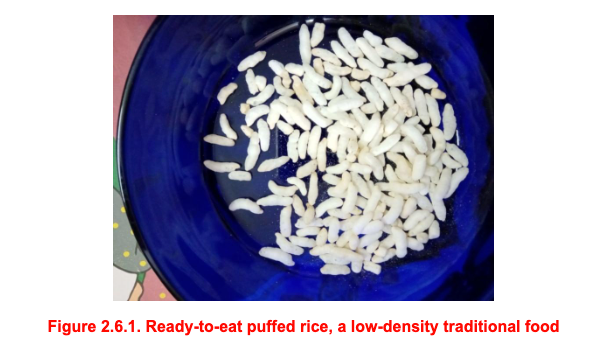Traditional Food of India
2.6.Puffed rice
Puffed rice is one of the popular traditional snacks in India and neighbouring countries (Figure 2.6.1). It is conventionally prepared from pregelatinised (parboiled) milled rice usually employing the sand roasting method. The advantages of puffed rice are an easy-to-prepare method, a cost-effective product, a good shelf-life and an attractive crisp soft texture. The low density of puffed rice also helps to satisfy the satiety of the consumers. Other names of puffed rice are muri, kadle puri and murmure.
Method of preparation
Puffed rice is prepared in small quantities at houses and cottage industries employing the batch process (Figure 2.6.2). Continuous processes are practiced in large-scale preparations. Parboiled rice is sprinkled with a small volume of salt solution, heated on a hot surface with occasional stirring and allowed for moisture conditioning for a short period. The samples are then subjected to sand roasting with continuous stirring when the expansion of kernels occurs. The hot sand is then separated by sieving for reuse.

Products made from puffed rice
Puffed rice is consumed as an anytime snack or even as breakfast, lunch and dinner. It is also eaten by adding a small amount of oil like mustard oil, chilli pieces/powder, pieces of onion and garlic, dry roasted or fried nuts, flaked rice and pulses, and fried curry leaves to make the product an attractive snack.
Puffed rice is formed into balls (called murir moa) using warm jaggery (gur) syrup as the binder as well as providing a mild sweet taste (Figure 2.6.3). It is popular as a cost-effective product among children. The product has a shelf-life of 3 to 4 months. Similarly, sweet-tasting puffed rice bars are also prepared where roasted nuts and sesame seeds, sugar, jaggery and honey are used.
Technical data
- Parboiled rice is used for puffing; even double parboiled rice is claimed to be better. The hard external surface and sealing of the cracks and fissures, obtained by parboiling process followed by drying occurs in the kernels. The surface acts as the barrier to hold steam of adequate pressure that leads to sudden expansion of the rice grain.
- The puffing quality of rice depends on several factors such as the chemical composition and physical characteristics. A strong positive correlation had been reported between amylose content and expansion ratio. The varieties like Swarna, Lalat, Gurjari, Jaya, GR-5 and GR-6 had been indicated to be suitable for appropriate puffing.
- Puffed rice showed a highly porous microstructure containing small and big air cells, and thin cell walls. Small air cells were mainly located on the periphery while bigger cavities were present in the inner parts of the sample. The thin air cell walls and the presence of many air cells are responsible for the soft crisp texture of the product.
- The details of the microstructure and texture of puffed rice are available. The texture varies with the moisture content of puffed rice.
- The shelf-life of puffed rice is 3 to 4 months if properly packaged in flexible packages after removing air or moisture present in the air. The loss of crispness due to the entrance of moisture is the reason for its decrease in sensory acceptance.
- The density of puffed rice is less than 100 kg/m3, and thus, it can be called a low-density product. The moisture content of available puffed rice is less than 3%, while total ash content is 2-7% and acid insoluble ash content is 0.1-0.2%.

Machinery
Soaking, mixing and sieving units, sand roasting facility and packaging machine are needed.
Requirements
- Developing a method for maintaining the crispness for a longer time will be helping the manufacturers and consumers. Good packaging with minimal air space (done by tapping to remove air) is an option. Some people use turmeric powder suspension before roasting to maintain crispness.
- It may be possible to use a salt roasting process or the microwave puffing method instead of sand roasting to decrease the silica content in the form of acid-insoluble ash in the product.

- There is a need to find a method to reduce salt, total ash and acid insoluble ash contents using alternative technologies. Extrusion cooking is an alternative approach, though the extruded product varies marginally in terms of texture and taste. The possibility of micronutrient fortification of extruded products is also possible.
Further reading
Bhattacharya, K.R. and Ali, S.Z. (2014). An introduction to rice-grain technology. Woodhead Publishing India Pvt. Ltd (CRC Press), New Delhi, India, pp 186-188.
Chandrasekhar, P. R. and Chattopadhyay, P. K. (1991). Rice puffing in relation to its varietal characteristics and processing conditions. Journal of Food Process Engineering 14, 261-277.
Joshi, N.D., Mohapatra, D. and Joshi, D.C. (2014). Varietal selection of some indica rice for production of puffed rice. Food and Bioprocess Technology 7, 299–305.
Ravi, R., Roopa, B.S. and Bhattacharya, S. (2007). Texture evaluation by uniaxial compression of some snack foods. Journal of Texture Studies 38, 135-152.
Roopa, B.S., Mazumder, P. and Bhattacharya, S. (2009). Fracture behavior and mechanism of puffed cereal during compression. Journal of Texture Studies 40: 157–171.
Saha, S., Jha, S., Tiwari, A., Jayapalan, S. and Roy, A. (2021). Considerations for improvising fortified extruded rice products. Journal of Food Science 86, 1180–1200.
Saha, S. and Roy, A. (2022). Selecting high amylose rice variety for puffing: A correlation between physicochemical parameters and sensory preferences. Measurement: Food 5, 100021.
Websites
- Live Puffed Rice Making in Sand | Famous Rs 10 Snack in Nagpur | Indian Street Food
- Murmura recipe | spicy puffed rice | spicy murmura chivda
- Preparation of puffed rice and products
